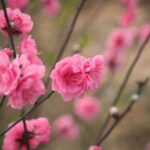A well-designed flower garden layout can transform any outdoor space into a stunning and tranquil retreat. Whether you have a small backyard or acres of land, creating a beautiful garden filled with vibrant blooms can bring joy and beauty to your surroundings. But where do you start?
In this article, we will explore the key steps and tips on how to design a flower garden layout that is not only visually appealing but also functional and sustainable. From assessing your space to selecting the right flowers and incorporating personal touches, we will guide you through the process of creating the perfect flower garden that reflects your style and preferences.
Designing a flower garden layout is more than just arranging flowers in an aesthetically pleasing arrangement. It involves careful consideration of various factors such as the size and shape of your garden, the ideal location for optimal sunlight, choosing appropriate flowers for different seasons, creating depth and height with vertical elements, ensuring ease of maintenance, and adding personal touches with unique garden decor. Understanding these aspects is crucial in order to create a well-balanced and successful flower garden.
By taking the time to plan and design your flower garden layout properly, you will be rewarded with a space that brings beauty, tranquility, and joy throughout the year. So let’s dive into each step of designing a flower garden layout in detail to help you achieve your gardening dreams.
Assessing Your Space
When it comes to designing a flower garden layout, one of the first steps is to assess your space and determine the size and shape of your garden. This is an important step because it will dictate how many flowers you can plant and how they will be arranged.
Start by measuring the area where you plan to create your flower garden. Take note of any existing structures, such as fences or walls, that may impact the size and shape of your garden. Consider factors such as sunlight exposure, soil conditions, and drainage as well.
Once you have determined the dimensions of your garden, consider the shape. You can choose from a variety of shapes such as rectangular, circular, or even irregular shapes for a more organic feel. The shape should complement your overall landscape design and blend well with the surrounding environment.
In order to visually plan your flower garden layout, you can use graph paper or specialized garden planning software that allows you to drag and drop different elements onto a virtual grid. This will help you better visualize how various plants and flowers will fit into your space.
| Factors to Consider | Data |
|---|---|
| Area Measurements | 10ft x 12ft |
| Shape | Rectangular |
| Sunlight Exposure | Full sun |
| Soil Conditions | Well-draining soil |
By carefully assessing your space and determining the size and shape of your flower garden, you can create a layout that maximizes its visual appeal and functionality. This step sets the foundation for the rest of your garden design process, allowing you to plan the placement of various flowers and elements in a cohesive manner.
Remember, your flower garden should not only be aesthetically pleasing but also practical and sustainable for long-term enjoyment. Taking the time to assess your space will help ensure that you make the most of your available area and create a beautiful flower garden that brings joy and beauty to your outdoor space.
Selecting the Right Spot
Finding the right spot for your flower garden is crucial to its success. The location you choose can determine the amount of sunlight your flowers receive, the soil conditions they will grow in, and even the overall aesthetic of your garden. Here are some important factors to consider when selecting the ideal location for your flower garden.
Sunlight
One of the most important considerations when choosing a spot for your flower garden is the amount of sunlight it will receive. Most flowering plants require at least 6 hours of direct sunlight per day, so it’s essential to find an area that gets adequate sun exposure. Take note of any large trees or structures that may shade the area during certain times of the day and plan accordingly.
Soil Quality
The quality of your soil can greatly impact the health and growth of your flowers. Before deciding on a location, assess the soil in that area. Is it well-draining or does it tend to hold moisture? Is it rich in nutrients or lacking in organic matter? You may need to amend the soil with compost or other organic matter if it is not ideal for growing flowers.
Accessibility
Consider how accessible your flower garden will be for maintenance purposes. Will you be able to easily water, weed, and care for your plants in this location? It’s important to choose a spot that allows for easy access so that you can enjoy tending to your garden without any difficulties.
Aesthetics
Lastly, think about how the location will fit into the overall aesthetics of your outdoor space. Consider aspects such as visibility from different areas, compatibility with existing landscaping features, and how it will complement other elements such as pathways or seating areas.
By considering factors such as sunlight, soil quality, accessibility, and aesthetics, you can find the perfect spot for your flower garden. Taking the time to select an ideal location will ensure that your flowers thrive and provide you with a beautiful and enjoyable garden space.
Choosing the Perfect Flowers
When designing a flower garden layout, one of the most important steps is choosing the perfect flowers to include. This involves identifying your personal preferences and researching different flower options that will thrive in your specific climate and soil conditions. By selecting the right flowers, you can create a visually stunning garden that suits your taste and provides year-round interest.
Identifying Your Preferences
Before diving into researching different flower options, take some time to identify your preferences. Consider what colors, scents, and sizes of flowers you are drawn to. Think about whether you prefer a more formal or informal garden aesthetic. It’s also important to take into account any specific theme or style you may want to incorporate into your garden design. Identifying your preferences will guide you in selecting flowers that align with your vision for the space.
Researching Different Flower Options
Once you have a clear idea of your preferred aesthetics, start researching the wide variety of flower options available. Look for flowers that are well-suited to your climate, as this will increase their chances of thriving in your garden. Consider factors such as sun exposure requirements, watering needs, and soil preferences for each flower type you are interested in.
Another important aspect to consider is bloom time. By selecting flowers that bloom at different times throughout the year, you can ensure that there will always be something in bloom in your garden. This will provide continuous color and interest throughout the seasons.
Additionally, think about incorporating a mix of annuals and perennials into your flower garden layout. Annuals add vibrant bursts of color but need to be replanted each year, while perennials come back year after year with minimal maintenance.
By carefully considering your preferences and researching different flower options suitable for your climate and soil conditions, you can select the perfect flowers for your flower garden layout. This will help create a visually appealing and harmonious space that brings beauty and joy throughout the year.
Designing With Colors
Designing a flower garden with a carefully curated color palette can create a visually stunning and harmonious space. By selecting the right combination of colors, you can evoke different moods and create a sense of balance in your garden. Here are some tips to help you create a vibrant and harmonious color palette for your flower garden:
1. Consider the basics of color theory: Understanding the basics of color theory can be helpful when creating a color palette for your flower garden. Colors can be grouped into warm (red, orange, yellow) and cool (blue, green, purple) tones. Warm colors can create an energetic and vibrant atmosphere, while cool colors are more calming and soothing. You can play with different combinations of warm and cool colors to achieve the desired effect in your garden.
2. Choose a dominant color: Start by choosing one or two dominant colors that will anchor your color scheme. These colors will be the main focus in your garden. Consider the overall look you want to achieve – whether it’s bold and dramatic or soft and romantic – and select your dominant colors accordingly.
3. Incorporate complementary colors: Complementary colors are those that are opposite each other on the color wheel, such as blue and orange or red and green. These combinations create a striking contrast that can make certain flowers stand out in your garden. Adding complementary colors to your palette can add depth and visual interest to your flower beds or borders.
4. Use analogous or monochromatic schemes: If you prefer a more harmonious look, consider using analogous or monochromatic color schemes. Analogous colors are those that are adjacent to each other on the color wheel, such as purple, blue, and green. This creates a smooth transition between hues and gives your garden a cohesive look. Monochromatic schemes, on the other hand, use variations of a single color for a more subtle effect.
Remember to consider factors such as sunlight exposure and the flowering times of different plants when selecting your color palette. With careful planning and consideration, you can create a flower garden that is not just visually appealing but also reflects your personal style and preferences.
Planning for Year-Round Bloom
One of the key aspects of designing a flower garden layout is planning for year-round bloom. Incorporating seasonal varieties into your garden will ensure that you have continuous color and interest throughout the year. By strategically selecting flowers that bloom at different times, you can create a visually stunning and ever-changing landscape.
To start planning for year-round bloom, make a list of flowers that thrive in each season. Determine which ones are suitable for your specific climate and soil conditions. Consider factors such as temperature, rainfall, and sunlight exposure to choose the right flowers for each season.
Next, think about the colors and textures you want to incorporate into your garden during each season. Create a color palette that complements your personal style and preferences. For example, bright and vibrant colors may be ideal for spring and summer, while warm hues like oranges and reds can add depth to an autumn garden.
Once you have identified the flowers you want to include in each season, consider their blooming periods and plan their placement accordingly. This will help ensure a smooth transition from one season to another with minimal gaps in bloom. You may also want to stagger plantings or use different varieties of the same flower to extend their blooming period.
Incorporating seasonal varieties into your flower garden layout not only adds visual interest but also attracts pollinators such as bees and butterflies. This helps promote biodiversity in your garden while creating a thriving ecosystem. With careful planning, you can enjoy colorful blooms throughout the year, transforming your garden into a breathtaking display of nature’s beauty.
Creating Height and Depth
When designing a flower garden layout, it is important to consider how to maximize the available space and create visual interest. One way to achieve this is by incorporating vertical and layered elements that add height and depth to your garden design.
Vertical elements such as trellises, arbors, or pergolas not only provide support for climbing plants but also create a sense of height in the garden. These structures can be strategically placed throughout your flower beds to add vertical interest and draw the eye upwards. Consider planting vines or climbing roses next to these structures to create a beautiful display of flowers reaching towards the sky.
Layering different types of plants is another effective technique for adding depth to your flower garden layout. By selecting plants with varying heights, you can create a visually appealing arrangement that makes the most of the available space. Place taller plants at the back of your garden beds, medium-sized plants in the middle, and shorter groundcovers or trailing plants towards the front. This layering effect adds dimension and creates a more dynamic display.
Additionally, incorporating hardscape features like retaining walls or raised beds can also help in creating height and depth in your garden design. These structures not only provide functional benefits such as holding soil in place and preventing erosion but also serve as attractive design elements that add visual interest and define different areas within your flower garden.
To summarize, creating height and depth in your flower garden layout is essential for maximizing space and creating an aesthetically pleasing design. Incorporating vertical elements like trellises or pergolas along with layering different plant heights can add visual interest and dimension to your garden.
Additionally, considering hardscape features such as retaining walls or raised beds can further enhance the overall design by adding structure and definition. By implementing these techniques, you can create a stunning flower garden that is both visually appealing and functional.
| Benefits of Creating Height and Depth | Incorporating Vertical and Layered Elements |
|---|---|
| Maximizes garden space | Trellises, arbors, or pergolas provide vertical interest |
| Adds visual interest and dimension | Layering plants with varying heights |
| Creates a dynamic and attractive display | Hardscape features like retaining walls or raised beds |
Considering Maintenance and Accessibility
Designing a flower garden layout is not just about creating a visually appealing space; it is also important to consider the maintenance and accessibility of your garden. After all, a well-designed garden should be easy to care for and enjoyable to spend time in. In this section, we will explore some key considerations when designing for maintenance and accessibility.
Firstly, it is essential to think about the amount of time and effort you are willing to put into maintaining your flower garden. If you have a busy schedule or limited gardening experience, opting for low-maintenance plants would be beneficial. Look for flowers that require minimal watering and pruning, as well as those that are disease and pest resistant. This will help ensure that your garden remains healthy with minimal effort on your part.
In addition to selecting low-maintenance plants, it is important to consider the accessibility of your garden. If you plan on spending time in your flower garden regularly, make sure pathways are wide enough for easy navigation and that they are made from materials that provide good traction even in wet conditions. Additionally, consider adding seating areas or benches where you can relax and enjoy the beauty of your garden.
To design for ease of care, grouping similar plants together can also be helpful as it allows for more efficient watering and maintenance. For example, planting flowers with similar water requirements in the same area will make watering easier as you can target specific zones rather than having to water each individual plant separately.
By considering maintenance and accessibility when designing your flower garden layout, you can create a space that not only looks beautiful but is also practical and enjoyable to maintain. Taking these factors into account will ultimately lead to a more successful and sustainable garden that brings years of pleasure and relaxation.
Adding Personal Touches
Incorporating personal touches into your flower garden is a great way to showcase your unique style and add charm and character to the space. By carefully selecting garden decor and accents, you can create a visually appealing and inviting atmosphere that reflects your personality. Here are some ideas on how to incorporate personal touches into your flower garden to make it truly your own.
One way to add a personal touch to your flower garden is by choosing decorative items that reflect your interests or hobbies. For example, if you love birds, you can incorporate birdhouses or bird feeders into your garden design. Not only will this provide a habitat for birds, but it will also add visual interest and create a sense of whimsy in the space.
Another way to showcase your style is through the use of garden art and sculptures. Whether it’s a beautifully crafted statue, a unique piece of metalwork, or an artistic mosaic, adding these elements can transform your flower garden into an outdoor gallery. Choose pieces that resonate with you personally and complement the overall design aesthetic of your garden.
In addition to decorative elements, consider incorporating functional accents that enhance the usability of your flower garden. For example, a comfortable seating area with cozy outdoor furniture can create an inviting space for relaxation and enjoyment. You could also add lighting elements such as fairy lights or lanterns to create ambiance in the evenings.
Adding personal touches to your flower garden not only makes it more visually appealing but also creates a space that feels uniquely yours. Experiment with different decor pieces and accents until you find ones that align with your style and preferences. Remember, the most important thing is to have fun with designing your flower garden layout and let it be an expression of who you are.
Conclusion
In conclusion, designing a flower garden layout involves several key steps and considerations. Firstly, it is important to assess the available space to determine the size and shape of your garden. This will help you plan how many flowers and plants you can accommodate. Additionally, selecting the right spot for your flower garden is crucial for optimal growth and health of the plants. Ensure that the location receives adequate sunlight and has proper drainage.
Once you have determined the basic framework of your garden, it is time to choose the perfect flowers. Consider your preferences, as well as factors such as climate and soil conditions, when researching different flower options. Creating a color palette for your garden is another important aspect of designing a flower garden layout. By carefully selecting flowers in various shades and hues, you can create a vibrant and harmonious display.
To ensure year-round bloom and interest in your garden, incorporate seasonal varieties that bloom at different times throughout the year. This will provide continuous color and prevent any lulls in visual appeal. Additionally, adding height and depth to your garden through vertical structures or layered planting techniques can maximize space utilization.
Maintenance should also be taken into consideration when designing your flower garden layout. Choose low-maintenance plants if you have limited time or prefer minimal upkeep. Furthermore, accessibility is important for both maintenance purposes and enjoyment of the garden. Ensure that pathways are incorporated for easy navigation through the space.
Finally, don’t forget to add personal touches to showcase your style in the garden. Incorporate decorative elements such as statues, fountains, or trellises that reflect your personality and create a welcoming atmosphere.
By following these key steps and tips outlined above, you can design a perfect flower garden layout that brings beauty and joy throughout every season. Happy gardening.
Frequently Asked Questions
How Do I Layout My Flower Garden?
When it comes to layout your flower garden, there are a few key factors to consider. Firstly, assess the space you have available and take note of any existing features or structures that may impact your design. Next, think about the style or theme you want for your garden – whether it’s formal, cottage-style, or contemporary, this will shape the overall arrangement of plants and flowers.
Consider the specific needs of your chosen flowers in terms of sunlight, soil type, and drainage. It’s generally recommended to group plants with similar requirements together to ensure their optimal growth. Additionally, think about incorporating elements such as pathways, focal points, and seating areas to enhance the overall aesthetic and functionality of your flower garden.
Is There an App to Plan a Flower Garden?
Yes, there are several apps available that can help you plan a flower garden. These apps often provide tools and features that allow you to visualize your garden layout before implementing it in reality. Some popular options include Garden Planner, iScape Garden & Outdoor Design App, and Home Outside: Landscape Design for Everyone.
These apps typically allow you to input details such as measurements and dimensions of your garden space, select plant varieties from a database or library, experiment with different layouts and arrangements, and even simulate how plants will look at different times throughout the year. They can be useful tools for both amateur gardeners looking for inspiration and experienced landscapers seeking a digital planning tool.
How Do I Make a Garden Layout Plan?
Making a garden layout plan involves several steps to ensure an organized and well-thought-out design. Start by measuring the dimensions of your garden area using a tape measure or any suitable measuring tool. Sketch out this measurement on graph paper or use online tools specifically designed for creating garden layouts. Take into account any existing structures like walls or fences that need to be incorporated into the plan.
Consider factors like sun exposure throughout the day when deciding where to place certain types of plants that require more shade or sunlight. Research different plant species’ growth habits and mature sizes to determine appropriate spacing. You can also experiment with different layouts by drawing or using digital tools, keeping in mind the overall aesthetics and functionality you want to achieve in your garden space. Once you finalize your plan, it will serve as a useful reference when it comes time to implement and plant your garden.

Welcome to my gardening blog! I am passionate about plants and enjoy sharing my knowledge and experiences with others. In this blog, I will write about everything related to gardening, from tips on how to get started to updates on my own garden projects.





